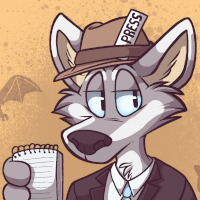A Menagerie of Heroes; A Rainfurrest Anthology – book review by Fred Patten.
by Patch O'Furr
Submitted by Fred Patten, Furry’s favorite historian and reviewer.
Dear Patch;
FurPlanet is advertising that its appearance at Further Confusion will be the final opportunity at present to buy the RainFurrest charity anthologies. FurPlanet is no longer carrying them after last December 31st and it is bringing its final printed copies for sale at FC 2016. The book is at least temporarily unavailable, because it will be up to the con to take over printing and selling after this year. – Fred
 A Menagerie of Heroes; A Rainfurrest Anthology, edited by Ryan Hickey and Garrett Biggerstaff.
A Menagerie of Heroes; A Rainfurrest Anthology, edited by Ryan Hickey and Garrett Biggerstaff.
Dallas, TX, FurPlanet Productions, September 2015, trade paperback $15.00 (320 pages).
Seattle’s annual RainFurrest convention has published a charity anthology every year since 2011, growing from 108 pages in 2011 to 269 pages in 2014. All stories are donated to RainFurrest by mid-June, and the anthology is printed by FurPlanet Productions in Dallas to be sold at the convention in September, with all proceeds donated to that year’s charity. RainFurrest 2015’s total donation was over $10,000 to the Cougar Mountain Zoo in Issaquah, Washington. The anthologies are subsequently sold through the FurPlanet catalogue.
In 2015 for the first time there were two charity anthologies; the “clean” A Menagerie of Heroes with 14 stories totaling 320 pages, and the “adult” Naughty Sexy Furry Writing; Enter at your own Risk with six stories totaling 124 pages. Here is the G- and PG-rated one, featuring RainFurrest 2015’s theme of Swords and Sorcery.
“Fox Confessor Brings the Flood” by Wilfred B. Wolf is a charming story, but you have to get through some clunky writing to read it. In a medieval Japanese fantasy setting, Gasu Yeo is a Bard, a gifted musician and a royal official sent out to spread the news and the latest royal pronouncements to the farthest corners of the Empire. He is also one of the first Kitsu Bards; one of the first of the Empire’s foxlike anthros to be accepted into the Bards. When he is assigned to visit a distant village that has never seen a Kitsu, he is mistaken for a mythical fox trickster bringing bad luck or a curse. Yeo must convince the human peasants that while he may look like a humanoid fox, he is as human and peaceful (and a royal official) as any of them. The story is delightful, even though given a choice of words, Wolf picks a flat one every time. Read the rest of this entry »






 GeneStorm. Book 2, Fort Dandelion, by Paul Kidd
GeneStorm. Book 2, Fort Dandelion, by Paul Kidd


 The Wind in the Willows, by Kenneth Grahame. Frontispiece by Graham Robertson.
The Wind in the Willows, by Kenneth Grahame. Frontispiece by Graham Robertson.